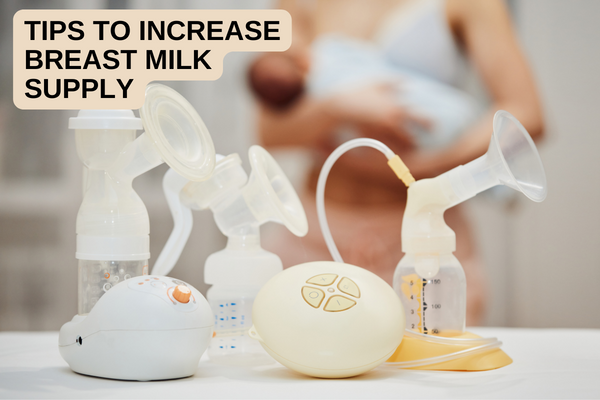Key Points
- Challenges and Delay in Milk Production: Mothers who undergo a C-section often face challenges like physical discomfort and emotional stress. These factors, along with the effects of surgery and medication, may delay the onset of mature milk production, making early breastfeeding support crucial.
- Effective Breastfeeding Positions: Post-C-section, specific breastfeeding positions such as the side-lying and under-arm (football) hold are recommended to avoid discomfort and pressure on the surgical incision, facilitating a more comfortable breastfeeding experience.
- Medication Safety During Breastfeeding: Most pain medications prescribed post-C-section, like Paracetamol and Ibuprofen, are safe for breastfeeding mothers. However, it's essential to consult with healthcare providers about medication safety to ensure they are compatible with breastfeeding.
- Importance of Early Breastfeeding and Support: Initiating breastfeeding within the first hour after birth, if possible, is beneficial for both mother and baby. Mothers should seek support from healthcare professionals, lactation consultants, and support groups to navigate challenges and establish successful breastfeeding post-C-section.
For countless new mothers, the act of breastfeeding is a cherished bond they look forward to sharing with their children. However, a C-section can add a whole different dynamic to breastfeeding, and mothers who undergo a C-section can experience some unique challenges and concerns.
Research has highlighted that mothers who deliver via C-section may stop breastfeeding earlier as compared to mothers who deliver vaginally. New mothers who have a C-section often require additional support and guidance to help them establish breastfeeding after a C-section. But once breastfeeding is established successfully, they will be able to continue breastfeeding the same as women who have had a vaginal birth.
In this comprehensive guide, we’ll explore the importance, challenges, and various facets of breastfeeding after a C-section, offering expert advice, debunking myths, and providing actionable tips for success.
Importance of breastfeeding after a C-section:
Breastfeeding is a natural and essential practice that offers numerous health benefits for both the mother and child including postnatal mental health benefits for the mother such as reducing the risk of postnatal depression. After a C-section, breastfeeding becomes crucial due to its role in helping the uterus contract and facilitating the healing process.
What are some issues you may encounter when breastfeeding after a C-section?
It is crucial for new mothers to start on the right foot as they initiate breastfeeding to meet their breastfeeding goals. However, trying to breastfeed while recovering from a major surgery like a C-section can be daunting and cause anxiety. You might encounter physical discomfort, tiredness, pain and emotional hurdles. You might not be able to move around easily after C-section and sometimes there could be the added challenge of having a drip in the arm. For some mothers, it may also take longer for the milk to come in than after a vaginal birth.
Breastfeeding after a C-section introduces unique challenges spanning medical, pharmacological, and emotional dimensions:
Post-Operative Care: After a C-section, immediate post-operative care is vital but could potentially delay the initiation of breastfeeding. In the majority of cases, the mother can breastfeed soon after the C-section delivery.
Emotional Challenges: Post C-section, mothers might grapple with feelings of inadequacy or anxiety, exacerbated by societal narratives around C-sections. Reframing this conversation to focus on individual experiences and resilience is crucial.
Delay in milk production: Studies have highlighted that C-sections can likely delay the start of mature milk production. During the initial few days after birth, the body produces colostrum (baby’s first milk). While colostrum is low in volume, it is full of antibodies and other protection essential for the baby. After 2 to 5 days of birth, the milk becomes more abundant. Sometimes the milk’s coming in may get delayed by a few days if the new mother had a C-section delivery.
Post-delivery medical needs of baby: If the baby has a medical need or needs to spend some time in the neonatal intensive care unit (NICU), this separation and distance from the mother can create a challenge in establishing breastfeeding
Medications: While recovering from the C-section surgery, the new mother is prescribed medications to manage the post-delivery pain. While essential for recovery, these medicines can raise concerns about their transfer to the baby through breast milk and cause hesitation from the mother’s end to initiate breastfeeding.
Anesthesia: The type of anesthesia used affects breastfeeding. Anesthesia can make the baby drowsy, which affects their ability to breastfeed and some babies can have an unorganized sucking reflex.
Thrush (Yeast Infections) Due to C-Section Antibiotics: Antibiotics administered during a C-section can disrupt your body’s natural yeast balance, leading to thrush while breastfeeding. This can make breastfeeding very painful. The pain can be severe enough to lead to early weaning. To mitigate this, maintain proper hygiene, consider probiotics, and seek professional consultation at the first signs of infection.
Breastfeeding Immediately After a C-section
Breastfeeding in the first hour after birth is recommended, as it helps increase the chances of successful breastfeeding. A C-section delivery is a major surgery, thus making it challenging to breastfeed within that first hour or so. If a nurse or your partner can help position the baby skin to skin, many babies will latch on and breastfeed. Even if you are not able to initiate breastfeeding right away, you can still protect the milk supply to establish a strong breastfeeding connection with your baby.
Recommendations for Successful Nursing While Recovering from C-section
You may have to undertake some planning if you already know that you are going for a C-section. The top goal should be to breastfeed frequently after the baby is born, in order to keep the milk flowing. It is always recommended to reach out for help if required.
Here are a few tips to remember:
- Practice skin-to-skin contact as it is a great way to keep the milk supply up, thus helping to establish a bond with your baby.
- If your baby is separated from you after the delivery, pump the breast milk every 2 to 3 hours.
- Respond to your baby’s cues to initiate feedings whenever requested, or at least every 2 to 3 hours.
- While recovering from surgery, you are caring for the baby as well as learning to breastfeed. That is a lot to do while you are still in recovery after a major surgery. Seek and accept offers of help. Ensure you get lots of rest while you recover.
- If you are not able to solve a breastfeeding problem on your own, connect with a breastfeeding consultant.
Tips for Successful Breastfeeding after C-section?
Here are some recommendations to make your breastfeeding journey easier and to deal with the potential challenges:
Plan for Early Breastfeeding: Post-operative care could potentially delay the initiation of breastfeeding. Aim to start breastfeeding as soon as it’s medically feasible. Where possible ask for skin to skin and try to breastfeed the baby within the first hour after the birth. Early initiation of breastfeeding can aid in milk production and establish a bond between you and your baby.
Opt for a Baby-Friendly Hospital: Research ahead of time. Hospitals with a ‘baby-friendly’ accreditation often have policies that support and promote immediate and uninterrupted breastfeeding. Choosing such hospitals can foster an environment conducive to early breastfeeding.
Be Aware of Hospital Policies: Familiarize yourself with the hospital’s protocols regarding post-operative care and breastfeeding after a C-section. Understanding these can help you navigate potential roadblocks and set clear expectations during your stay.
Consult a Lactation Specialist: Engage with a lactation consultant for practical advice, techniques, and support tailored to breastfeeding post a C-section. Connecting with one before your due date can provide valuable insights.
Post-delivery medical needs: Even if the baby needs medical care, the new mother can still breastfeed successfully. Start, pumping the breast milk within 6 hours after giving birth. This will help kickstart your milk supply. After reuniting with the baby, you can initiate breastfeeding.
Self-Advocacy is Key: While the medical team prioritizes your well-being, it’s crucial to voice your feelings and preferences. Whether it’s your desire to breastfeed immediately after the surgery or concerns about medications impacting breastfeeding, ensure you communicate your wishes.
Breast Awareness: In the transformative journey of motherhood, a mother’s breasts not only nourish the baby but also offer vital health cues. By understanding and observing the changes in their breasts, mothers can differentiate between normal lactational changes and potential concerns. This proactive approach ensures the baby’s optimal nutrition and prioritizes the mother’s breast health, facilitating timely interventions when necessary.
Also Read- 10 Top breastfeeding tips from Experts
Breastfeeding Positions That Work Best after a C-section
For new mothers recovering from a C-section delivery, specific breastfeeding positions can be comfortable, while some are painful. It is therefore important to be aware of the right positions to keep the baby’s weight off the healing incision. Due to this, traditional breastfeeding positions such as the cradle or cross-cradle hold may not be comfortable during the early weeks.
Positions that are best for post-C-section breastfeeding are the side-lying and the under-arm or football hold. With these positions, the baby cannot make direct contact with the incision. Here’s how to do them:
In the side-lying hold:
Step 1: Lie on the bed on one side.
Sep 2: Support your head as well as back with pillows.
Step 3: Lie your baby so they face you and tuck them up close to your body.
For the under-arm hold:
Step 1: Position the baby at your side, under your arm.
Step 2: Use cushions for back support.
Step 3: Put a cushion on your side to support the baby.
There could be other possible positions that work for you. Experiment to determine what feels best for both you and your baby.
Also Read- Breastfeeding Positions: Which is the Best for You and Your Baby?
Are Pain Medications Safe to Take While Nursing After a C-Section?
Managing pain post C-section is crucial, and pain medications play an essential role in this. While recovering from the C-section surgery, the new mother is prescribed medications to manage the post-delivery pain. Pain medications are compatible with breastfeeding, as only small amounts of the medications pass into the milk.
Paracetamol (Acetaminophen): Safe in recommended doses due to its low concentration in breast milk.
Ibuprofen: Generally considered safe with minimal presence in breast milk.
Narcotic Pain Relievers: Use with caution. Short-term doses might be acceptable, but prolonged use can pose risks.
Others (like aspirin): Not typically recommended due to potential risks to the baby.
Always consult with your doctor before taking any medication while breastfeeding.
Also Read- C-Section: 10 Things No One Told You About the Procedure
Is it Normal for a C-section Baby to Experience Weight Loss?
Does Breastfeeding Stop Me from Getting Pregnant?
Breastfeeding does have a connection to fertility, acting as a natural contraceptive to some extent. The hormone prolactin, elevated during breastfeeding, can suppress ovulation, thus reducing fertility. However, this isn’t a foolproof contraceptive method. Fertility varies among individuals, and it’s possible to get pregnant while breastfeeding. If the goal is to prevent pregnancy, consult with a healthcare provider for a reliable contraceptive method.
What Should I Do If My Baby Coughs Up Mucus?
It’s not uncommon for newborns, especially those delivered via C-section, to cough up mucus. During vaginal delivery, the birth canal helps clear excess fluid from the lungs. With C-sections, this natural process is bypassed, resulting in your baby coughing up residual mucus post-delivery.
Response: Stay calm and gently turn the baby’s head to the side, allowing the mucus to drain. If coughing continues or if breathing difficulties are observed, seek immediate medical care. Regular pediatrician consultations can offer guidance tailored to your baby’s needs.
Conclusion
How Can Veira Assist with Your Breastfeeding Journey?
Need more breastfeeding help? We would love to help. With Veira Life, you will not be on this journey alone. Our dedicated Veira Coaches – a select team of certified doulas, midwives, childbirth educators, and lactation counselors – have extensive experience assisting new mothers during this transition. Whether you have questions about early breastfeeding or concerns about post-C-section care, they’re available to guide, ease anxieties, and preempt potential challenges. Dive into our resource-rich prenatal classes designed to support you throughout your motherhood journey and reach out to a Veira Coach for support.
With Veira, personalized guidance for post-C-section breastfeeding is just a click away. Register with Veira and experience the difference.
References
FAQs
Typically, breastfeeding can begin soon after a C-section, often within the first hour. This early initiation helps enhance breastfeeding success.
Yes, some babies born via C-section may initially struggle with breastfeeding. Factors like drowsy effects of spinal anesthesia, delayed skin-to-skin contact and maternal recovery may affect this. However, with the right guidance, breastfeeding can be successfully established.
Yes, milk will come in after a C-section, though it may be delayed. This is due to stress from the surgery. Generally, the transition from colostrum to milk happens by 72 hours post-birth but can be delayed by one or two days more post surgery.
Milk production after a C-section can be slower due to the surgical interventions that can impact the post birth hormones.
C-section delivery can initially make breastfeeding more challenging due to recovery from the operation. Despite this, many mothers successfully breastfeed post-C-section with appropriate support.







